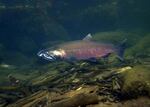The Oregon Department of Forestry settled a lawsuit with an environmental group on Thursday that will mean larger buffers between logging roads and streams.
The Center for Biological Diversity, Cascadia Wildlands and Native Fish Society sued the department in 2018 alleging it was endangering federally protected coho salmon by building logging roads that caused sediment to spill into streams in Tillamook and Clatsop state forests.

In this file photo from 2009, a Coho salmon swims in Eagle Creek, Ore.
Courtesy of Rick Swart / Oregon Deparment of Fish and Wildlife
The lawsuit says state crews would carve roads through forested areas for clear-cutting and timber sales, and those roads were on steep slopes above streams crucial to Oregon Coast coho salmon. It says a lack of adequate buffers caused sediment to spill into streams, and sometimes triggered landslides.
“We brought this case because the department’s practice has been usually not to buffer those high-energy stream channels on steep slopes,” said Amy Atwood, the Center for Biological Diversity’s attorney. “We’re glad to see that through this agreement, the department has taken some strides in the direction of starting to do that. It’s not everything that we would have hoped for, but it is a big step in the right direction.”
As part of the agreement, ODF will expand stream buffers from 25 feet to 120 feet — meaning the department can’t conduct logging or thinning within those zones. These protections apply to all fish-bearing streams, as well as large and medium streams that don’t typically bear fish. The department will also buffer some upland sites where landslides start.
Oregon Coast coho salmon have been federally protected since 1998. In order to comply with the Endangered Species Act, non-federal landowners can compile a habitat conservation plan outlining how they plan to protect the endangered species on their land.
Mike Wilson, ODF forestry division chief, said the department’s early attempts at putting together a plan in 2001 “did not come to fruition” for a variety of factors, including disagreements between forestry officials and logging businesses. Instead of completing a plan, the department opted to comply with federal protections by conducting regular species surveys. But that approach is costly, according to the state, so the department embarked on drafting a habitat conservation plan in February 2022. It’s slated to be complete by this summer.
Wilson said the plan calls for implementing 120-foot wide no-cut buffer zones near streams on all state forest land.
